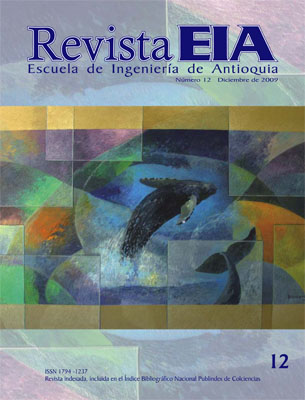SÍNTESIS Y CARACTERIZACIÓN DE HIDROGELES DE ALCOHOL POLIVINÍLICO POR LA TÉCNICA DE CONGELAMIENTO/DESCONGELAMIENTO PARA APLICACIONES MÉDICAS (SYNTHESIS AND CHARACTERIZATION OF POLYVINYL ALCOHOL HYDROGELS BY FREEZING/THAWING TECHNIQUE FOR MEDICAL APPLICATI
SÍNTESIS Y CARACTERIZACIÓN DE HIDROGELES DE ALCOHOL POLIVINÍLICO POR LA TÉCNICA DE CONGELAMIENTO/DESCONGELAMIENTO PARA APLICACIONES MÉDICAS (SYNTHESIS AND CHARACTERIZATION OF POLYVINYL ALCOHOL HYDROGELS BY FREEZING/THAWING TECHNIQUE FOR MEDICAL APPLICATI


This work is licensed under a Creative Commons Attribution-NonCommercial-NoDerivatives 4.0 International License.
Copyright statement
The authors exclusively assign to the Universidad EIA, with the power to assign to third parties, all the exploitation rights that derive from the works that are accepted for publication in the Revista EIA, as well as in any product derived from it and, in in particular, those of reproduction, distribution, public communication (including interactive making available) and transformation (including adaptation, modification and, where appropriate, translation), for all types of exploitation (by way of example and not limitation : in paper, electronic, online, computer or audiovisual format, as well as in any other format, even for promotional or advertising purposes and / or for the production of derivative products), for a worldwide territorial scope and for the entire duration of the rights provided for in the current published text of the Intellectual Property Law. This assignment will be made by the authors without the right to any type of remuneration or compensation.
Consequently, the author may not publish or disseminate the works that are selected for publication in the Revista EIA, neither totally nor partially, nor authorize their publication to third parties, without the prior express authorization, requested and granted in writing, from the Univeridad EIA.
Show authors biography
Usando diferentes ciclos de congelamiento/descongelamiento se prepararon hidrogeles de alcohol polivinílico semicristalino 7,5 % y 12 % en concentración. La cinética y el grado de hinchamiento, los estados del agua y la resistencia a la tracción se evaluaron por gravimetría, calorimetría diferencial de barrido (DSC) y pruebas de tracción, respectivamente. Los resultados indican que los hidrogeles de menor concentración y con menor número de ciclos presentan cinética y grado de hinchamiento mejores y menor resistencia a la tracción. Las DSC permitieron determinar la presencia de agua libre y de agua vinculada congelable. Las características de estos hidrogeles permiten clasificarlos para diferentes aplicaciones médicas.
Abstract: Using different cycles of freeze-thawing, semicrystalline polyvinyl alcohol hydrogels were synthesized in concentrations of 7.5 % and 12 %. The kinetic and grade of swelling, states of water and the tensile strength were calculated by gravimetry, by differential scanning calorimetry, DSC, and the tensile tests respectively. The results show that hydrogels with less concentration and cycles have better grade and kinetic of swelling, while the tensile strength is lower. The DSC results allow us to determine the free and freezable bound waters in our hydrogels. The characteristics obtained from these hydrogels lead their classification for different medical applications.
Article visits 659 | PDF visits 268
